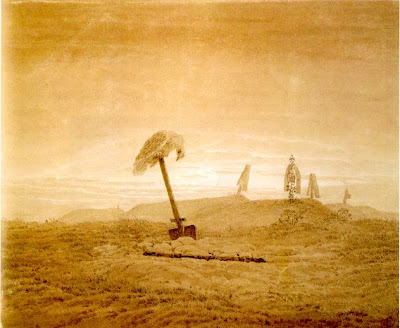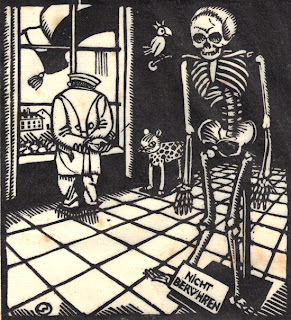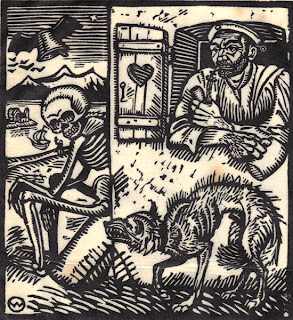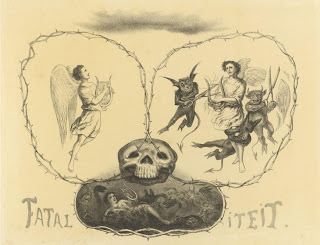 |
| Owl Flying against a Moonlit Sky (1836-37) |
Caspar David Friedrich (1774 – 1840) was a 19th-century German Romantic landscape painter, generally considered the most important German artist of his generation. He is best known for his mid-period allegorical landscapes which typically feature contemplative figures silhouetted against night skies, morning mists, barren trees or Gothic ruins. His primary interest as an artist was the contemplation of nature, and his often symbolic and anti-classical work seeks to convey a subjective, emotional response to the natural world. Friedrich's paintings characteristically set a human presence in diminished perspective amid expansive landscapes, reducing the figures to a scale that, according to the art historian Christopher John Murray, directs "the viewer's gaze towards their metaphysical dimension".
 |
| Landscape with Grave, Coffin and Owl (1836-37) |
We are interested in his gothic period of loneliness and death. We read in wikipedia:
 |
| Vulture on a Spade (1835) |
Both Friedrich's life and art are marked with an overwhelming sense of loneliness. This becomes more apparent in his later works, from a time when friends, members of his family and fellow pioneers of early romanticism began to either become distant from him or die.
 |
| Owl upon the Grave Marker (1836-37) |
Art historians and some of his contemporaries attribute the melancholy in his art to the losses suffered during his youth to the bleak outlook of his adulthood, while Friedrich's pale and withdrawn appearance helped reinforce the popular notion of the "taciturn man from the North".
 |
| Hiker at the Milestone (1802) |
 |
| Coffin and Grave (1836) |
Friedrich suffered depressive episodes in 1799, 1803–1805, c.1813, in 1816 and between 1824 and 1826. There are noticeable thematic shifts in the works he produced during these episodes, which see the emergence of such motifs and death symbols as vultures, owls, graveyards and ruins. From 1826 these motifs became a permanent feature of his output, while his use of color became more dark and muted.
 |
| Owl in a Gothic Window (1836) |
Carus wrote in 1929 that Friedrich "is surrounded by a thick, gloomy cloud of spiritual uncertainty", while in 2004 the psychiatrist Carsten Spitzer wrote that he believed during his life, Friedrich suffered prolonged inertia, a suicide attempt and what the artist himself described as a "dreadful weariness".
 |
| Boy sleeping on a grave (1801-03) |
 |
| Funeral scene at the beach (1799) |
 |
| Old Heroes Graves (1812) |
A dilapidated monument inscribed "Arminius" invokes the Germanic chieftain, a symbol of nationalism, while the four tombs of fallen heroes are slightly ajar, freeing their spirits for eternity. Two French soldiers appear as small figures before a cave, lower and deep in a grotto surrounded by rock, as if farther from heaven.
 |
| Graveyard under snow (1826) |
Friedrich sketched memorial monuments and sculptures for mausoleums, reflecting his obsession with death and the afterlife. He also created some of the funerary art in Dresden's cemeteries.
 |
| The Abbey in the Oakwood (1809-10) |
In "The Abbey in the Oakwood" a procession of monks, some of whom bear a coffin, head toward the gate of a ruined Gothic church in the center of the painting. Only two candles light their way. A newly dug grave yawns out of the snow in the foreground, near which several crosses can be faintly discerned. This lower third of the picture lies in darkness—only the highest part of the ruins and the tips of the leafless oaks are lit by the setting sun. The waxing crescent moon appears in the sky.The Abbey in the Oakwood is based upon studies of the ruins of Eldena Abbey, which reappear in several other paintings.
Eldena Abbey may well have had personal meaning for Friedrich, as it was destroyed during the Thirty Years War by invading Swedish troops, who later used bricks from the abbey to construct fortifications. In the painting Friedrich draws a parallel between those actions and the use of Greifswald churches as barracks by occupying French soldiers. Thus, the funeral becomes a symbol of "the burial of Germany's hopes for resurrection".


































.jpg)
1300229409.jpg)
1kwo1_500.jpg)
2708281255_ae4e793454_o.jpg)
39nao1_1280.jpg)
_n.jpg)

















.jpg)



